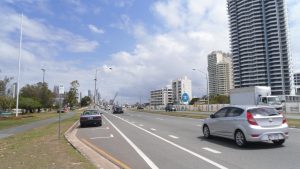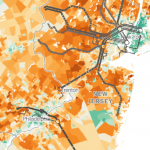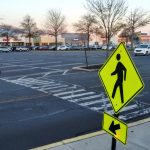New Jersey Future Blog
We Need a Better Way of Measuring How Much People Drive—And Why
May 23rd, 2022 by Tim Evans
 People driving cars and trucks from one place to another is not only a big contributor to New Jersey’s carbon footprint, but also leads to many hours wasted behind the wheel and many dollars spent to build and maintain the state’s road network. In New Jersey, the average licensed driver drives about 33 miles a day. While transportation planners and the general public are aware that daily life involves a lot of driving, the reasons for all this vehicular travel are less widely understood. A better way of measuring vehicle-miles traveled (VMT) would provide some insight into the problem—and what to do about it.
People driving cars and trucks from one place to another is not only a big contributor to New Jersey’s carbon footprint, but also leads to many hours wasted behind the wheel and many dollars spent to build and maintain the state’s road network. In New Jersey, the average licensed driver drives about 33 miles a day. While transportation planners and the general public are aware that daily life involves a lot of driving, the reasons for all this vehicular travel are less widely understood. A better way of measuring vehicle-miles traveled (VMT) would provide some insight into the problem—and what to do about it.
The Transportation and Land Use Connection
The transportation sector accounts for 41% of New Jersey’s greenhouse gas (GHG) emissions (according to the NJDEP Greenhouse Gas Emissions Inventory), mainly from cars and trucks burning gasoline and emitting CO2 as they move people and goods around the state. One of the potential avenues for mitigating climate change through the reduction of carbon emissions is to reduce the amount that people need to drive, a strategy that—unlike simply electrifying the vehicle fleet—would also pay multiple other dividends. Less driving would result in less traffic congestion and the waste and aggravation it entails, fewer tax dollars spent on building and maintaining roads, and fewer hours logged behind the wheel for New Jersey’s drivers, allowing more time for leisure and entertainment.
So how might we reduce the number of miles the average person needs to drive? To answer this question, we need to understand the factors that incentivize driving in the first place, particularly in the relationship between land development and transportation. Decisions about where to locate homes, offices, stores, schools, and other public spaces in relation to each other have profound and lasting effects on travel behavior. The farther apart we build different types of destinations, the more vehicular travel will be required to access them. Conversely, when destinations are closer together, car trips get shorter, and some trips can be taken without needing a car at all, whether by non-motorized means or by public transportation, which functions much more efficiently when major destinations are clustered within walking distance of stations.
In other words, travel behavior is a function of land use decisions, and vice versa. Putting destinations farther apart creates a greater need to drive, and the more people drive, the more new development will be built to accommodate car travel. Although this relationship between travel behavior and land use makes intuitive sense, it is not currently the basis on which car travel is measured and interpreted.
We Care About Where People Drive, but Not About Why People Drive
It is often said that a society measures what it cares about, and cares about what it measures. Governments do make efforts to measure driving, but the metrics are primarily based on roads and how many vehicles use them, rather than on the drivers of those vehicles and where they live. The New Jersey Department of Transportation page about measuring VMT explains that “New Jersey’s official estimate of vehicle miles traveled (VMT) is a product of the Highway Performance Monitoring System (HPMS) Program. VMT is a measurement of the amount of traffic on a given mile of roadway. Deriving New Jersey’s VMT estimate involves multiplying the traffic volume on each HPMS section, the section length and expansion factor then summing the product to yield VMT for any desired aggregation level.”
One might infer from its use of traffic counts to measure VMT that the state has an interest in the amount of traffic on its roadways and how extensively those roadways are used, which can indicate where roadway maintenance and improvements are most needed. But measuring VMT based on traffic volumes at particular points on the road network rather than on where vehicle trips originate suggests that our main interests are not so focused on why people drive in the first place. It is difficult to quantify how land development patterns influence travel behavior—and thus difficult to imagine how to reduce the need to drive—if vehicular travel cannot be linked to where drivers live. In order to develop a better understanding of the features of the built environment that prompt people to drive—and to implement land use policies that will allow for less driving in the future— an alternate approach to measuring VMT becomes necessary.
The Value of VMT Data for Explaining Travel Behavior
Fortunately, we already have a device for measuring travel at the level of the individual vehicle: the odometer. Two of New Jersey’s neighbors—Pennsylvania and Delaware—collect odometer readings annually or bi-annually as part of the vehicle registration renewal process. Massachusetts even conducted a Vehicle Census between 2009 and 2014 that made VMT data compiled from odometer readings available at the municipal level. New Jersey’s Motor Vehicle Commission could easily start collecting odometer readings as part of the administrative process and provide the aggregated data to the appropriate state agencies for purposes of studying VMT and monitoring success in reducing it.
Such data would enable miles driven to be associated with residential locations rather than with road segments. Annual odometer readings, when combined with the address at which the vehicle is registered, would allow annual VMT to be tallied by place, ideally at a unit of geography for which data are available to describe some aspects of the built environment. Per-capita VMT for a given unit of geography could be compared to indicators like housing density, mix of uses (residential, retail, etc.), access to public transportation, and other land-use variables that might be expected to affect how much daily travel is likely to take place by car. Examining the relationship between development patterns and driving could yield insights into what kinds of land use solutions might be effective in reducing people’s need to drive.
Aggregating miles traveled by the geographic area of driver residence would also facilitate the modeling of travel behavior as a function of development patterns for purposes of transportation planning. Observing actual driver behavior for different kinds of places would allow transportation planners to anticipate the amount of new VMT likely to be generated by new development of a specific type and density. By combining information about the surrounding development patterns with the approach of the Institute of Transportation Engineers’ Trip Generation Manual, transportation professionals could not only estimate the number of trips likely to be generated by a given land-use type (as facilitated by the Manual), but could also better anticipate both the average trip length of automobile trips and the number of trips that might be taken by non-vehicular means, based on observed travel behavior in places with similar density, mix of uses, and street network connectivity.
Modeling driving behavior as a function of the land development characteristics of where people live, work, and shop would be critical to any effort to estimate the VMT or GHG impacts of new development, as California and Colorado now require, and New Jersey ought to consider.
Being able to observe differences in per-capita VMT among different parts of New Jersey could be helpful in setting realistic VMT reduction targets, by demonstrating possibilities under different land-use scenarios. For example, transportation and land-use professionals could make inferences along these lines: If we could increase the number of New Jerseyans living in places with development patterns similar to, say, Montclair by X%, we could expect to decrease per-capita VMT by Y%, given the observed travel behavior of people already living in such places.
Making Sure Electric Vehicles Pay Their Way
In addition to its potential to inform a GHG reduction strategy based on reducing VMT, measuring VMT based on individual vehicles rather than traffic volumes also has implications for a strategy focused on electrification of the vehicle fleet. Electric vehicles (EVs) figure prominently in the Murphy administration’s (and most of the rest of the world’s) plan for reining in our carbon emissions. But widespread adoption of EVs represents a looming conundrum in terms of raising revenue to pay for our road network: EVs do not burn gasoline and hence do not pay gasoline taxes. Given that these vehicles will continue to use the road network, imposing wear and tear and contributing to congestion right alongside their gasoline-burning peers, how do we ensure that the owners of electric vehicles continue to pay their fair share?
One promising option is a VMT tax, which would collect a per-mile fee from the owner of each vehicle based on the number of miles driven each year. Oregon launched a voluntary program in 2015 to test the concept and is now considering making it mandatory for certain types of vehicles starting in 2026. Utah joined Oregon and started its own pilot program in 2020. The Infrastructure Investment and Jobs Act, which passed last year, includes a pilot program to encourage additional states to implement VMT taxes.
Collecting such fees is impossible if VMT is not tracked at the level of the individual vehicle. Measuring VMT from odometer readings rather than from traffic counts would thus help advance two key prongs of a holistic GHG reduction strategy—the decarbonization of travel and the reduction of the need to travel in the first place. The data would shed light on the relationship between land development patterns and travel behavior, thereby pointing toward land-use solutions that would reduce the need to drive, while at the same time addressing the uncertainties about transportation revenues that will be a vexing byproduct of vehicle electrification. If we care about reducing GHG emissions from the transportation sector, it makes sense to start measuring VMT the right way.
Related Posts
Tags: drive, Driving, electric vehicles, Transportation, travel, vehicle, VMT
















